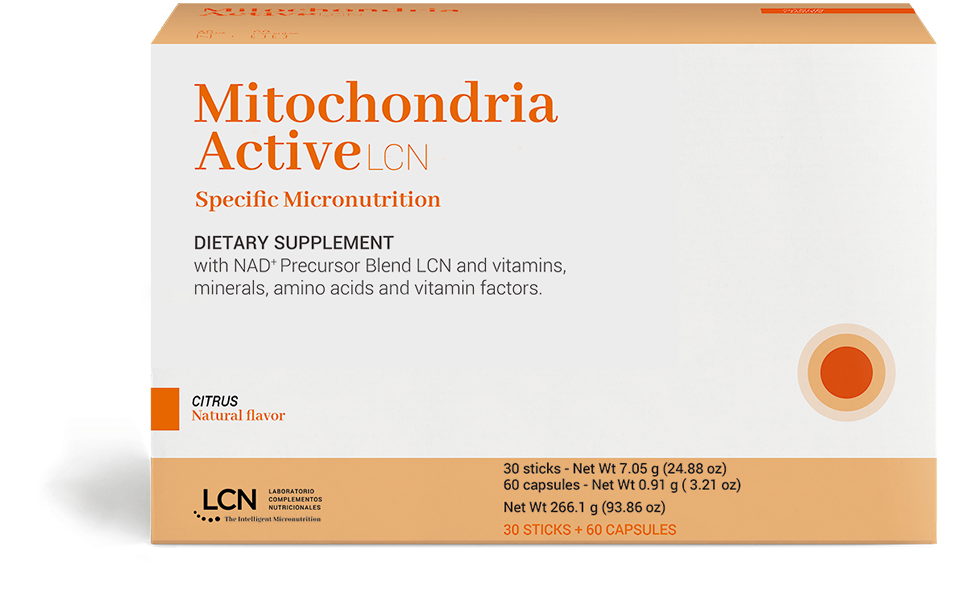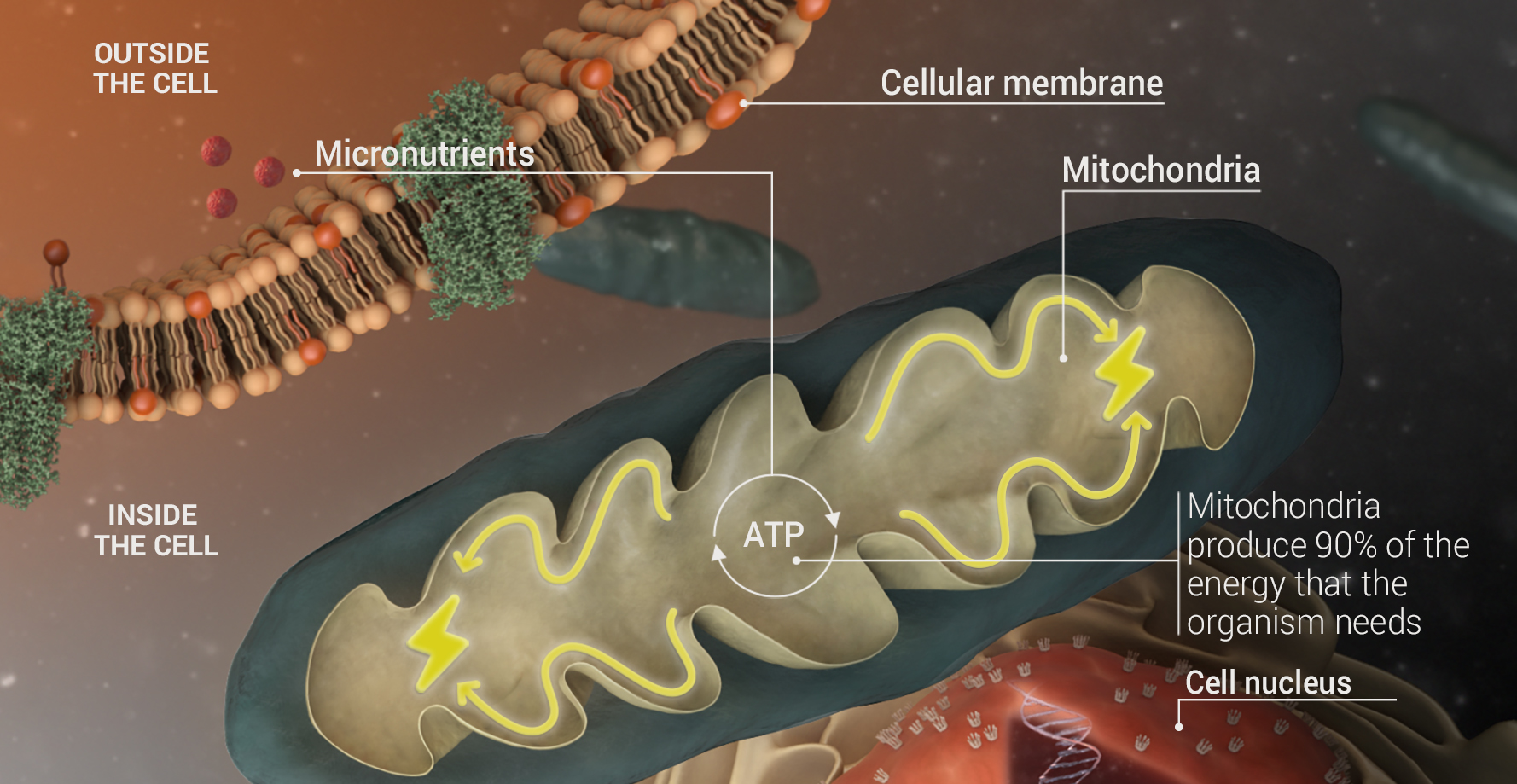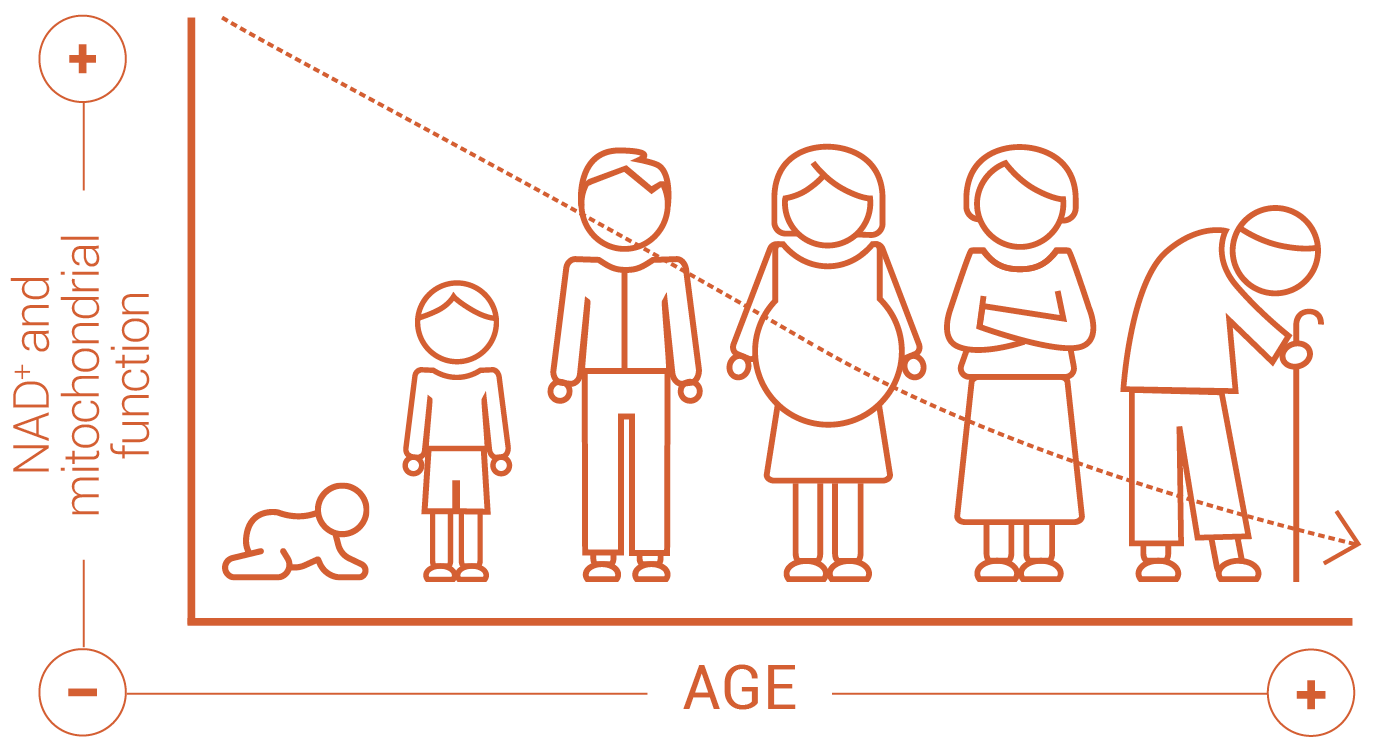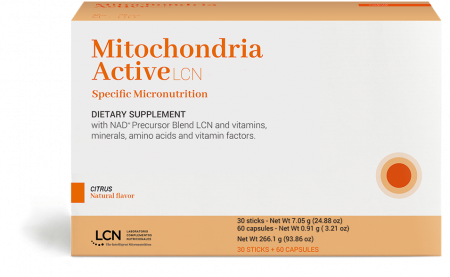
Mitochondria produce 90% of the energy we need from the air we breathe and the foods eat. This energy, known as ATP, is what keeps us alive.
Our quality of life can be altered by deficient mitochondrial functioning, which can be related to the dysfunction of different bodily organs, as this accelerates the aging process and associated chronic processes.
¿Qué son las
mitocondrias?
What are
mitochondria?
What are
mitochondria?

Mitochondria are organelles that form part of our cells. Their main function is to produce the daily energy (ATP) our bodies need through cellular respiration.
Mitochondria are dynamic organelles; they can move between cells, divide or shrink according to our physical state. They act as sensors in the cellular medium and will attempt to respond appropriately and promptly to any change affecting the functioning of tissues and organs. The more dynamic they are, the greater our vitality and well-being.
The energy produced by mitochondria in the form of ATP (adenosine triphosphate) is used by the organs and tissues to function and maintain and repair themselves properly. It is also used to transform fats, carbohydrates, proteins, etc. to other compounds required by the body.
This enables our bodies to perform daily actions like moving, thinking, breathing, exercising, reading, defending against external aggressions, etc.
Mitochondrial energy keeps us healthy, staves off disease and helps the body’s cells stay young. That’s why mitochondrial health is considered fundamental for a long, quality life.
Accelerated or unhealthy aging is related to a series of factors such as inappropriate lifestyles, stress, overnutrition, obesity, exposure to toxic substances, changes to circadian rhythms, which lead to alteration of the mitochondria and reduced ATP production.
For optimal health and healthy aging in the future, the key factor is to optimize mitochondrial health. At the same time as they generate energy, they also naturally generate waste products such as free radicals (highly reactive molecules that can damage cells, membranes, lipids, proteins and DNA). With age, reversal of this oxidative damage is slower and more difficult.
THE KEY MARKER OF YOUTH IS THE STATE OF OUR MITOCHONDRIA
Deficient mitochondrial functioning can alter our quality of life and accelerate the physiological aging process and related chronic processes.
Mitochondria are the powerhouses of our cells, but without intake of the optimal micronutritional combinations that contribute to ATP and NAD+ synthesis, they cannot do their work. In addition, in situations of prolonged stress, convalescence, periods of high energy demand, etc., mitochondria can start to function sub-optimally or enter into dysfunctional states.
 As occurs with other molecules synthesized by the body, NAD+ is constantly being created and destroyed. With age, the equilibrium between synthesis and degradation is disrupted, as NAD+ generation slows down and the enzymes and pathways for NAD+ consumption increase.
As occurs with other molecules synthesized by the body, NAD+ is constantly being created and destroyed. With age, the equilibrium between synthesis and degradation is disrupted, as NAD+ generation slows down and the enzymes and pathways for NAD+ consumption increase.What is
Mitochondria ActiveLCN
and what does it do?

Micronutrient complex that promotes complete energetic activation and cellular function
Mitochondria Active is a dietary supplement that enhances normal energetic function because it contains the proprietary NAD+ Precursor Blend LCN consisting of tryptophan and two vitamers of niacin: nicotinamide and nicotinic acid, which contribute to normal energetic metabolism and to reducing tiredness and fatigue*.
NAD+ Precursor Blend LCN is accompanied by a broad-spectrum micronutritional complex (glycine, creatine, acetyl L-carnitine, taurine, N-acetyl cysteine, vitamin C, magnesium, R-alpha-lipoic acid, coenzyme Q10, calcium pantothenate, pyrroloqui-noline quinone, riboflavin 5’-phosphate, thiamine, pyridoxal 5’-phosphate, L-me-thylfolate, biotin, methylcobalamin and dibencozide, selenium) formulated to contribute to and assist in:
- Normal muscle functioning and normal protein synthesis. Normal functioning of the nervous system*.
- Normal psychological functioning, normal intellectual performance and normal synthesis and metabolism of certain neurotransmitters, such as serotonin and dopamine*.
- Normal functioning of the heart*.
- Normal functioning of the immune system. Maintenance of vision under normal conditions*.
- Regulation of hormonal activity and thyroid function. Protection of cells against oxidative damage*.
- The cell division process needed for maintenance of tissues and organs*.
*These statements have not been evaluated by the Food and Drug Administration. This product is not intended to diagnose, treat, cure or prevent any disease.
Mitochondria Active supplies specific micronutrients for nourishing mitochondria:
Creatine: involved in the energetic pathway of ATP.
Taurine: a non-protein amino acid that is essential for multiple functions. It facilitates the entry of magnesium into cells.
Acetyl L-carnitine: in acetylated form for greater bioavailability of the L-carnitine.
R-lipoic acid: R isomer 100%, bioidentical to that produced by the body.
PQQ: molecule involved in vital mitochondrial processes.
Coenzyme Q10: in a complex with gamma-cyclodextrin, which improves its solubility in water and increases the bioavailability of the micronutrient 18-fold.
Glycine with N-acetyl cysteine: limiting amino acids for the synthesis of glutathione.
Mitochondria Active is a broad-spectrum micronutritional complex composed of:
Tryptophan, nicotinamide, and nicotinic acid.
This is the optimal combination of the different precursors that enhance NAD+ synthesis.
Glycine, N-acetyl cysteine and creatine.
Amino acids are the basic structures for building peptides and proteins. They are necessary for the formation of muscles, neurotransmitters, enzymes, etc.
Taurine, coenzyme Q10, R-lipoic acid, acetyl L-carnitine and PQQ.
Vitamin factors are nutritional compounds with properties similar to those of vitamins but which do not meet the criteria to be considered as such. Among these molecules, we find micronutrients produced by endogenous synthesis but which can be insufficient in certain stages of life or under pathological or pharmacological conditions.
Vitamin C, thiamine, riboflavin 5’-phosphate, calcium pantothenate, pyridoxal 5’-phosphate, folates, methylcobalamin, dibencozide, biotin, magnesium and selenium.
These are substances of vitamin or mineral origin that complement the action of an enzyme. Although they have few chemical similarities, they share many commonalities in metabolic functions, control of oxidation and genetic expression.
Más información sobre Mitochondria
ActiveLCN
- Ingredients
- Composition
- Directions
- Warnings
- Useful tips
STICK: Glycine; Magnesium Biglycinate; Creatine Monohydrate; Taurine; Calcium Ascorbate; Coenzyme Q10 (Ubiquinone with Gamma-Cyclodextrin Complex); L-Trypotophan; Nicotinamide; Calcium Pantothenate; Nicotinic Acid; Riboflavin 5’-Phosphate; Nicotinic Acid; Pyridoxal 5’-Phosphate; Thiamine Hydrochloride; Selenium-enriched Yeast; Calcium L-Methylfolate; D-Biotin; 5’-Deoxyadenosylcobalamin (Dibencozide); Methylcobalamin.
Other ingredients: Natural Lemon Flavor; Citric Acid; Silicon Dioxide.
CAPSULE: N-Acetyl L-Carnitine; N-Acetyl Cysteine; R-Alpha-Lipoic Acid; Pyrroloquinoline Quinone.
Other ingredients: Hypromellose; Purple Carrot Juice Concentrate; Microcrystalline Cellulose; Silicon Dioxide; Magnesium Stearate.
Lactose-free / Gluten-free / No phytochemicals / Suitable for vegans

1 stick and 2 capsules a day in a single dose more than 20 minutes before breakfast or lunch, or as indicated by a professional. Dissolve the stick in water. In the first week, the recommended dosage is half a packet and 1 capsule.
In some individuals, Mitochondria Active can intensify the yellow color of urine (due to the vitamin B2), a harmless effect.
As with any other product, do not take Mitochondria Active if you are allergic or intolerant to any of its components. Keep Mitochondria Active out of the reach and sight of children.
If your doctor or nutritionist/dietitian gives you advice or a specific diet, you should always follow their instructions.
- Try to eat dinner at least 3 hours before going to bed.
- It is advisable to allow more than 12 hours to elapse between dinner and breakfast.
- Limit consumption of carbohydrate-rich foods (bread, pasta, breakfast cereals, potatoes, sweet fruits, etc.), especially at night.
- Limit the consumption of sweet foods rich in fructose and simple sugars: cakes and pastries, jams, jellies, all types of soft drinks, natural and industrial fruit juices, syrups, candies, “light” foods and beverages, ice cream, dairy desserts and dried fruits (figs, dates, raisins, prunes).
- Limit consumption of processed foods (fresh and frozen) and all types of preserved and semi-preserved foods.
- Get up and move around frequently. Break the habit of being sedentary.
- Engage in activities that strengthen the large muscle groups (upper and lower limbs and torso) with strength-building exercises.
- Do aerobic exercise according to your possibilities.
- Consult the PAC Dietary Recommendations on the LaboratorioLCN website (www.laboratoriolcn.com) and the Basic Micronutrition products: CN Base, Petit CN Base, Omega Base and Amino Base.
